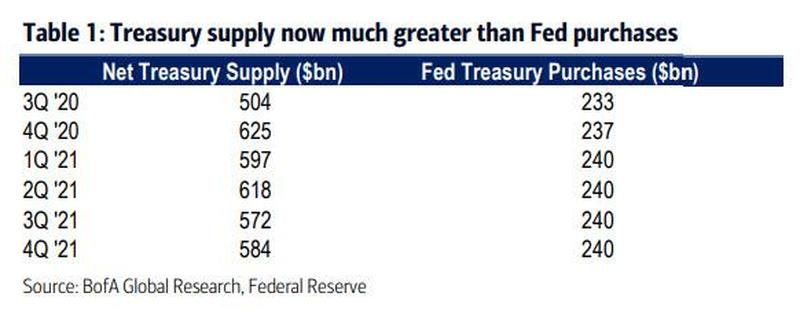Fed Would Need to Double Quantitative Easing to Keep Pace With US Debt
The US government is increasingly relying on the Federal Reserve to prop up the Treasury market and absorb the trillions of dollars in bonds it’s issuing in order to fund its massive budget deficits. The Fed now holds a record 16.5% of US debt. And it’s going to have to buy trillions of dollars of additional Treasuries in 2021 to keep pace with government borrowing.
In other words, there is no end in sight to quantitative easing. In fact, the central bank will have to double its scheduled monthly QE in 2021 to catch up to where it was in 2020.
In the last 12 months, the Fed has doubled its holdings of Treasuries, adding a staggering $2.4 trillion in US government bonds to its balance sheet – most of that since March. The Fed’s total share of US debt has spiked from 9.3% in Q1 to 16.5%.
In March and April alone, the Fed bought $1.56 trillion in Treasuries. During that same time period, the US Treasury issued $1.56 trillion in bonds. In other words, the Fed effectively monetized 100% of the new federal debt accumulated in March and April.
In the last year, the Fed has added over $3 trillion to its balance sheet. That’s roughly equal to the record $3.1 trillion budget deficit the US government ran in fiscal 2020.
There is no end in sight to the borrowing and spending. Many analysts expect another $3 trillion deficit in 2021 with additional stimulus spending needed to prop up the economy in the aftermath of COVID-19. As Peter Schiff said in a recent podcast, “It doesn’t matter if COVID goes away.”
The monetary and fiscal policies that resulted from COVID are here to stay. In fact, they’re going to be expanded, especially here in the United States because we took on so much additional debt to fight COVID – now the problem is the debt, not the disease. The disease that we really have is excess debt and excess money printing. And the Fed’s cure for that is to print even more money so we can go even deeper into debt.”
As reported by ZeroHedge, Bank of America analyst Michael Hartnett calculated that “Treasury supply will significantly outstrip Fed purchases in Q4 & Q1,” even without factoring in the possibility of another major fiscal stimulus.

The Treasury Department is projecting a net issuance of $2.4 trillion in debt. But the Fed is currently scheduled to monetize less than half of the total – approximately $960 billion. Even though this is an extraordinary amount of money printing and debt monetization, it doesn’t come close to closing the gap considering the Fed monetized virtually every dollar of net debt issuance in 2020.
The open market simply can’t absorb all of these Treasury bonds.
We’re already seeing signs that the foreign market is drying up. In 2008, foreign investors held over 50% of US outstanding public debt. Today, that number is below 35%. China and Japan are the biggest foreign investors in US Treasuries. Over the past five years, their combined holdings have remained relatively stable, but their share of the total debt has fallen from over 13% in 2015 to about 8.7% today. In fact, China has been dumping US debt. This indicates they are nearly tapped out.
The bottom line is there is only so much demand for US debt. As the market is flooded with Treasuries, the US government depends on the Fed to pick up the slack.
As ZeroHedge summed up, “In short: the Fed needs to more than double its scheduled monthly QE in 2021 just to catch up to where it was in 2020.”
Without the Fed soaking up trillions in Treasuries, the glut of bonds on the market would crash the price and push interest rates up – something the Federal Reserve cannot allow to happen. So, the Fed has to monetize the debt via quantitative easing. The central bank buys bonds on the open market with money created out of thin air. This creates artificial demand and pushes interest rates artificially low.
Without the Fed’s intervention in the bond market, it would be virtually impossible for the US government to borrow money at the current level. Interest rates would have to soar in order to entice average investors to buy US Treasuries. The market would collapse.
Other central banks face the same challenge. The Bank of England and the Reserve Bank of Australia have already announced expansions to their QE programs and the European Central Bank is expected to announce a dramatic increase in its QE in January. Variant Perception projects the ECB “may end up absorbing all government supply in 2021.”
ZeroHedge predicts the Fed will follow suit.
With the RBA, BOE and ECB all set to monetize 100% of domestic net issuance – in other words, central banks will henceforth fund the entire sovereign budget deficit which is what MMT and helicopter money is all about – it’s only a matter of time before Jerome Powell will join the club, and we expect that at some point in the next 3-4 months, the Fed will announce it too will double its monthly rate of debt purchases.”





 Since Nayib Bukele became president of El Salvador, El Salvador has been in American media and global political discussion more than ever. While much of the attention focuses on Bukele’s mass incarceration of gang members and a decline in homicide of over 70%, Bukele has also drawn attention to his favoritism towards Bitcoin and how he […]
Since Nayib Bukele became president of El Salvador, El Salvador has been in American media and global political discussion more than ever. While much of the attention focuses on Bukele’s mass incarceration of gang members and a decline in homicide of over 70%, Bukele has also drawn attention to his favoritism towards Bitcoin and how he […] With gold hitting yet another awe-inspiring all-time high in the wake of Powell’s remarks reassuring markets (more or less) to expect rate cuts in 2024, a few analysts are pointing out risk factors for a correction — so is there really still room to run?
With gold hitting yet another awe-inspiring all-time high in the wake of Powell’s remarks reassuring markets (more or less) to expect rate cuts in 2024, a few analysts are pointing out risk factors for a correction — so is there really still room to run? Gold hit a new all-time nominal high, surpassing the previous record set in December of the previous year. The precious metal’s price reached approximately $2,140, indicating a robust and continuing interest in gold as a safe-haven asset, despite a rather peculiar lack of fanfare from the media and retail investors. This latest peak in gold […]
Gold hit a new all-time nominal high, surpassing the previous record set in December of the previous year. The precious metal’s price reached approximately $2,140, indicating a robust and continuing interest in gold as a safe-haven asset, despite a rather peculiar lack of fanfare from the media and retail investors. This latest peak in gold […] The gold price has been surging, with unprecedented central bank demand gobbling up supply. It has been a force to behold — especially as US monetary policy has been relatively tight since 2022, and 10-year Treasury yields have rocketed up, which generally puts firm downward pressure on gold against USD.
The gold price has been surging, with unprecedented central bank demand gobbling up supply. It has been a force to behold — especially as US monetary policy has been relatively tight since 2022, and 10-year Treasury yields have rocketed up, which generally puts firm downward pressure on gold against USD.  Total gold demand hit an all-time high in 2023, according to a recent report released by the World Gold Council. Last week, the World Gold Council (WGC) released its Gold Demand Trends report, which tracks developments in the demand for and use of gold around the world. Excluding over-the-counter (OTC) trade, 2023 gold demand fell slightly from 2022 […]
Total gold demand hit an all-time high in 2023, according to a recent report released by the World Gold Council. Last week, the World Gold Council (WGC) released its Gold Demand Trends report, which tracks developments in the demand for and use of gold around the world. Excluding over-the-counter (OTC) trade, 2023 gold demand fell slightly from 2022 […]